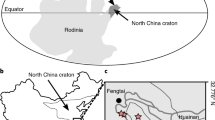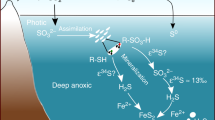Abstract
The Proterozoic aeon (2.5 to 0.54 billion years (Gyr) ago) marks the time between the largely anoxic world of the Archean (> 2.5 Gyr ago)1 and the dominantly oxic world of the Phanerozoic (< 0.54 Gyr ago). The course of ocean chemistry through the Proterozoic has traditionally been explained by progressive oxygenation of the deep ocean in response to an increase in atmospheric oxygen around 2.3 Gyr ago. This postulated rise in the oxygen content of the ocean is in turn thought to have led to the oxidation of dissolved iron, Fe(II), thus ending the deposition of banded iron formations (BIF) around 1.8 Gyr ago1,2. An alternative interpretation suggests that the increasing atmospheric oxygen levels enhanced sulphide weathering on land and the flux of sulphate to the oceans. This increased rates of sulphate reduction, resulting in Fe(II) removal in the form of pyrite as the oceans became sulphidic3. Here we investigate sediments from the ∼1.8-Gyr-old Animikie group, Canada, which were deposited during the final stages of the main global period of BIF deposition. This allows us to evaluate the two competing hypotheses for the termination of BIF deposition. We use iron–sulphur–carbon (Fe–S–C) systematics to demonstrate continued ocean anoxia after the final global deposition of BIF and show that a transition to sulphidic bottom waters was ultimately responsible for the termination of BIF deposition. Sulphidic conditions may have persisted until a second major rise in oxygen between 0.8 to 0.58 Gyr ago4,5, possibly reducing global rates of primary production and arresting the pace of algal evolution6.
This is a preview of subscription content, access via your institution
Access options
Subscribe to this journal
Receive 51 print issues and online access
$199.00 per year
only $3.90 per issue
Buy this article
- Purchase on Springer Link
- Instant access to full article PDF
Prices may be subject to local taxes which are calculated during checkout



Similar content being viewed by others
References
Holland, H. D. The Chemical Evolution of the Atmosphere and Oceans (Princeton Univ. Press, Princeton, 1984)
Cloud, P. E. A working model of the primitive Earth. Am. J. Sci. 272, 537–548 (1972)
Canfield, D. E. A new model for Proterozoic ocean chemistry. Nature 396, 450–453 (1998)
Derry, L. A., Kaufmann, A. J. & Jacobsen, S. B. Sedimentary cycling and environmental change in the Late Proterozoic: Evidence from stable and radiogenic isotopes. Geochim. Cosmochim. Acta 56, 1317–1329 (1992)
Canfield, D. E. & Teske, A. Late Proterozoic rise in atmospheric oxygen concentrations inferred from phylogenetic and stable isotope studies. Nature 382, 127–132 (1996)
Anbar, A. D. & Knoll, A. H. Proterozoic ocean chemistry and evolution: A bioinorganic bridge? Science 297, 1137–1142 (2002)
Drever, J. I. Geochemical model for the origins of Precambrian banded iron formations. Geol. Soc. Am. Bull. 85, 1099–1106 (1974)
Pufahl, P. K. & Fralick, P. W. Depositional controls on Paleoproterozoic shallow-water iron formation accumulation, Gogebic Range, Wisconsin, U.S.A. Sedimentology 54, 791–808 (2004)
Derry, L. A. & Jacobsen, S. B. The chemical evolution of Precambrian seawater: Evidence from REEs in banded iron formations. Geochim. Cosmochim. Acta 54, 2965–2977 (1990)
Ojakangas, R. W. in Early Proterozoic Geology of the Great Lakes Region (ed. Medaris, L. G.) Geol. Soc. Am. Mem. 160, 49–66 (1983).
Fralick, P. W., Davis, D. W. & Kissin, S. A. The age of the Gunflint Formation, Ontario, Canada: single zircon U-Pb age determinations from reworked volcanic ash. Can. J. Earth Sci. 39, 1085–1091 (2002)
Kissin, S. A., Vallina, D. A., Addison, W. D. & Brumpton, G. R. New zircon ages from the Gunflint and Rove Formations, northwestern Ontario. Lake Superior Institute Proc. 49, 43–44 (2003)
Raiswell, R., Newton, R. & Wignall, P. B. An indicator of water-column anoxia: Resolution of biofacies variations in the Kimmeridge Clay (Upper Jurassic, U.K.). J. Sedim. Res. 71, 286–294 (2001)
Poulton, S. W. & Canfield, D. E. Development of a sequential extraction procedure for iron: Implications for iron partitioning in continentally-derived particulates. Chem. Geol. (submitted)
Raiswell, R. & Canfield, D. E. Sources of iron for pyrite formation in marine sediments. Am. J. Sci. 298, 219–245 (1998)
Poulton, S. W. & Raiswell, R. The low-temperature geochemical cycle of iron: From continental fluxes to marine sediment deposition. Am. J. Sci. 302, 774–805 (2002)
Anderson, T. F. & Raiswell, R. Sources and mechanisms for the enrichment of highly reactive iron in euxinic Black Sea sediments. Am. J. Sci. 304, 203–233 (2004)
Berner, R. A. & Raiswell, R. C/S method for distinguishing freshwater from marine sedimentary rocks. Geology 12, 365–368 (1984)
Raiswell, R. & Berner, R. A. Pyrite formation in euxinic and semi-euxinic sediments. Am. J. Sci. 285, 710–724 (1985)
Carrigan, W. J. & Cameron, E. M. Petrological and stable isotope studies of carbonate and sulfide minerals from the Gunflint Formation, Ontario: Evidence for the origin of early Proterozoic iron-formation. Precambr. Res. 52, 347–380 (1991)
Shen, Y., Canfield, D. E. & Knoll, A. H. Middle Proterozoic ocean chemistry: Evidence from the McArthur Basin, Northern Australia. Am. J. Sci. 302, 81–109 (2002)
Lyons, T. W. Sulfur isotope trends and pathways of iron sulfide formation in upper Holocene sediments of the anoxic Black Sea. Geochim. Cosmochim. Acta 61, 3367–3382 (1997)
Passier, H. et al. Sulphidic Mediterranean surface waters during Pliocene sapropel formation. Nature 397, 146–149 (1999)
Schidlowski, M., Hayes, J. M. & Kaplan, I. R. in Earth's Earliest Biosphere: Its Origin and Evolution (ed. Schopf, J. W.)) 149–186 (Princeton Univ. Press, Princeton, 1983)
Strauss, H. The sulfur isotopic record of Precambrian sulfates: new data and a critical evaluation of the existing record. Precambr. Res. 63, 225–246 (1993)
Canfield, D. E. & Raiswell, R. The evolution of the sulfur cycle. Am. J. Sci. 299, 697–723 (1999)
Habicht, K. H., Gade, M., Thamdrup, B., Berg, P. & Canfield, D. E. Calibration of sulfate levels in the Archean ocean. Science 298, 2372–2374 (2002)
Shen, Y., Knoll, A. H. & Walter, M. R. Evidence for low sulphate and anoxia in a mid-Proterozoic marine basin. Nature 423, 632–635 (2003)
Arnold, G. L., Anbar, A. D., Barling, J. & Lyons, T. W. Molybdenum isotope evidence for widespread anoxia in mid-Proterozoic oceans. Science 304, 87–90 (2004)
Brocks, J. J., Love, G. D., Summons, R. E. & Logan, G. A. Purple sulfur bacteria in an intensely stratified Paleoproterozoic sea. Geochim. Cosmochim. Acta 68(11S), A796 (2004)
Acknowledgements
We thank M. Jirsa from the Geological Survey of Minnesota and the staff at the Department of Natural Resources in Ontario, Canada for help in locating and accessing core material. This research was supported by a Marie Curie Individual Fellowship (S.W.P.) and the Danish National Research Foundation (Danish Grundforskingsfond).
Author information
Authors and Affiliations
Corresponding author
Ethics declarations
Competing interests
The authors declare that they have no competing financial interests.
Supplementary information
Supplementary Information
Contains a referenced note; Supplementary Figure S1 (Fe speciation in sediment cores from the Mt. McRae Shale); Supplementary Table S1 (Analytical data for the Rove Formation) and Supplementary Table S2 (Analytical data for the Gunflint Formation). (DOC 211 kb)
Rights and permissions
About this article
Cite this article
Poulton, S., Fralick, P. & Canfield, D. The transition to a sulphidic ocean ∼ 1.84 billion years ago. Nature 431, 173–177 (2004). https://doi.org/10.1038/nature02912
Received:
Accepted:
Issue Date:
DOI: https://doi.org/10.1038/nature02912
This article is cited by
-
Sulphur Isotopic Studies of Pyrite from Gogi Uranium Deposit, Bhima Basin, Karnataka
Journal of the Geological Society of India (2021)
-
Surge of ore metals in seawater and increased bio-activity: a tracer of VHMS mineralization in Archaean successions, Yilgarn Craton, Western Australia
Mineralium Deposita (2021)
-
The Syntrophy hypothesis for the origin of eukaryotes revisited
Nature Microbiology (2020)
-
Modern arsenotrophic microbial mats provide an analogue for life in the anoxic Archean
Communications Earth & Environment (2020)
-
Regional nutrient decrease drove redox stabilisation and metazoan diversification in the late Ediacaran Nama Group, Namibia
Scientific Reports (2020)
Comments
By submitting a comment you agree to abide by our Terms and Community Guidelines. If you find something abusive or that does not comply with our terms or guidelines please flag it as inappropriate.



